TOYOTA 4RUNNER 2016 N280 / 5.G Owners Manual
Manufacturer: TOYOTA, Model Year: 2016, Model line: 4RUNNER, Model: TOYOTA 4RUNNER 2016 N280 / 5.GPages: 528, PDF Size: 12.12 MB
Page 451 of 528
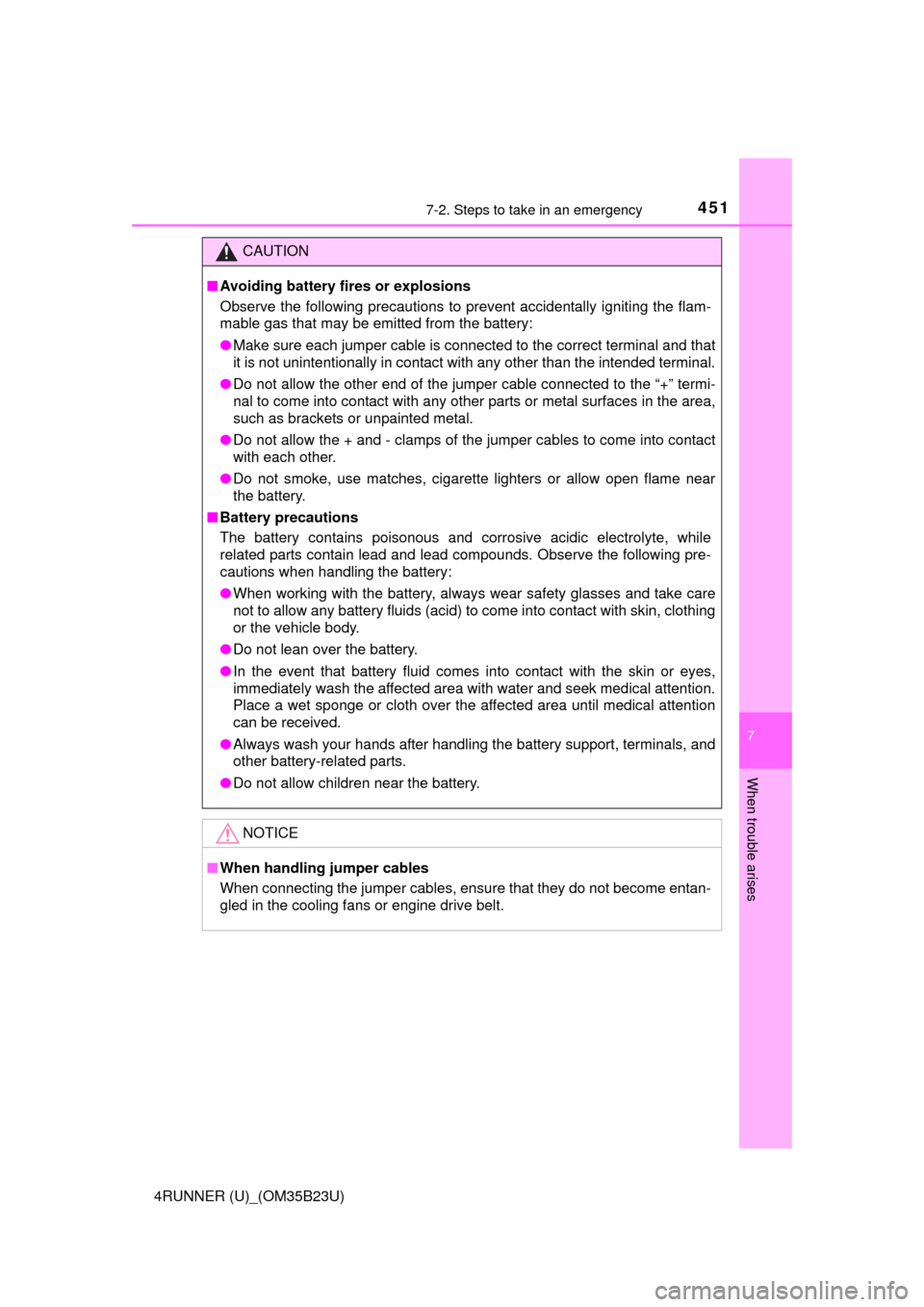
4517-2. Steps to take in an emergency
7
When trouble arises
4RUNNER (U)_(OM35B23U)
CAUTION
■Avoiding battery fires or explosions
Observe the following precautions to prevent accidentally igniting the flam-
mable gas that may be emitted from the battery:
●Make sure each jumper cable is connected to the correct terminal and that
it is not unintentionally in contact with any other than the intended terminal.
●Do not allow the other end of the jumper cable connected to the “+” termi-
nal to come into contact with any other parts or metal surfaces in the area,
such as brackets or unpainted metal.
●Do not allow the + and - clamps of the jumper cables to come into contact
with each other.
●Do not smoke, use matches, cigarette lighters or allow open flame near
the battery.
■Battery precautions
The battery contains poisonous and corrosive acidic electrolyte, while
related parts contain lead and lead compounds. Observe the following pre-
cautions when handling the battery:
●When working with the battery, always wear safety glasses and take care
not to allow any battery fluids (acid) to come into contact with skin, clothing
or the vehicle body.
●Do not lean over the battery.
●In the event that battery fluid comes into contact with the skin or eyes,
immediately wash the affected area with water and seek medical attention.
Place a wet sponge or cloth over the affected area until medical attention
can be received.
●Always wash your hands after handling the battery support, terminals, and
other battery-related parts.
●Do not allow children near the battery.
NOTICE
■When handling jumper cables
When connecting the jumper cables, ensure that they do not become entan-
gled in the cooling fans or engine drive belt.
Page 452 of 528
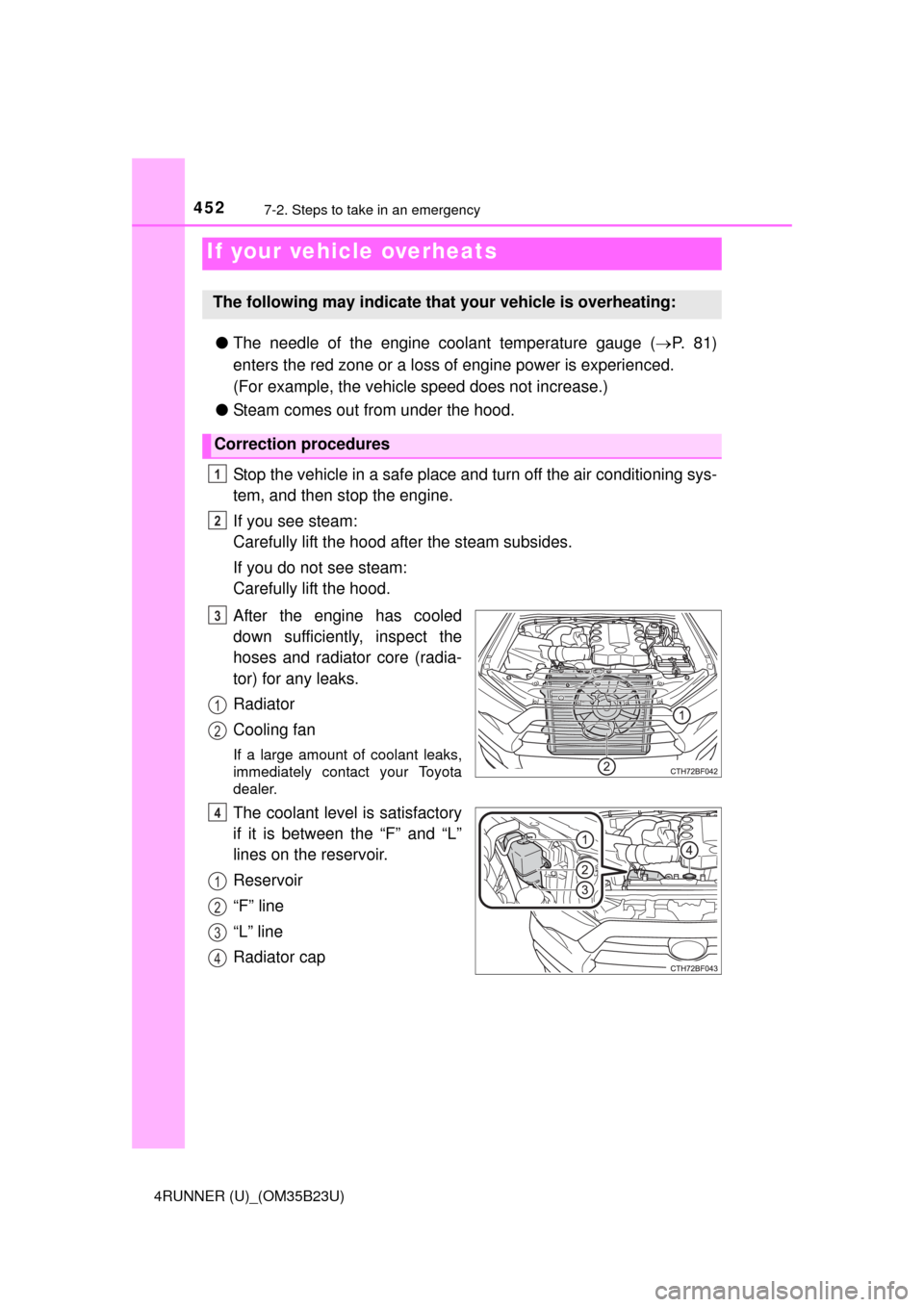
4527-2. Steps to take in an emergency
4RUNNER (U)_(OM35B23U)
●The needle of the engine coolant temperature gauge (P. 8 1 )
enters the red zone or a loss of engine power is experienced.
(For example, the vehicle speed does not increase.)
●Steam comes out from under the hood.
Stop the vehicle in a safe place and turn off the air conditioning sys-
tem, and then stop the engine.
If you see steam:
Carefully lift the hood after the steam subsides.
If you do not see steam:
Carefully lift the hood.
After the engine has cooled
down sufficiently, inspect the
hoses and radiator core (radia-
tor) for any leaks.
Radiator
Cooling fan
If a large amount of coolant leaks,
immediately contact your Toyota
dealer.
The coolant level is satisfactory
if it is between the “F” and “L”
lines on the reservoir.
Reservoir
“F” line
“L” line
Radiator cap
If your vehicle overheats
The following may indicate that your vehicle is overheating:
Correction procedures
1
2
3
1
2
4
1
2
3
4
Page 453 of 528
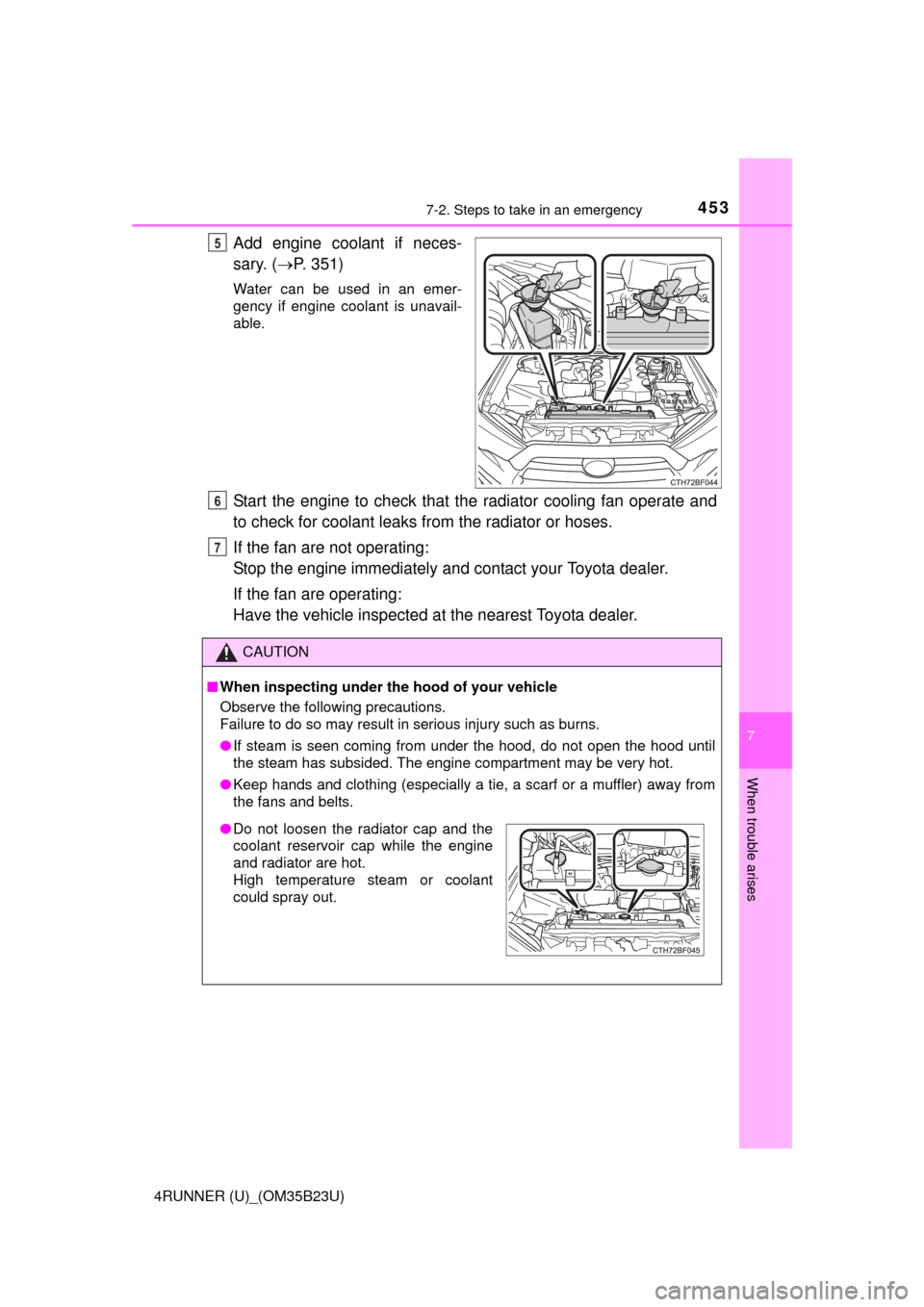
4537-2. Steps to take in an emergency
7
When trouble arises
4RUNNER (U)_(OM35B23U)
Add engine coolant if neces-
sary. (P. 351)
Water can be used in an emer-
gency if engine coolant is unavail-
able.
Start the engine to check that the radiator cooling fan operate and
to check for coolant leaks from the radiator or hoses.
If the fan are not operating:
Stop the engine immediately and contact your Toyota dealer.
If the fan are operating:
Have the vehicle inspected at the nearest Toyota dealer.
5
CAUTION
■When inspecting under the hood of your vehicle
Observe the following precautions.
Failure to do so may result in serious injury such as burns.
●If steam is seen coming from under the hood, do not open the hood until
the steam has subsided. The engine compartment may be very hot.
●Keep hands and clothing (especially a tie, a scarf or a muffler) away from
the fans and belts.
6
7
●Do not loosen the radiator cap and the
coolant reservoir cap while the engine
and radiator are hot.
High temperature steam or coolant
could spray out.
Page 454 of 528
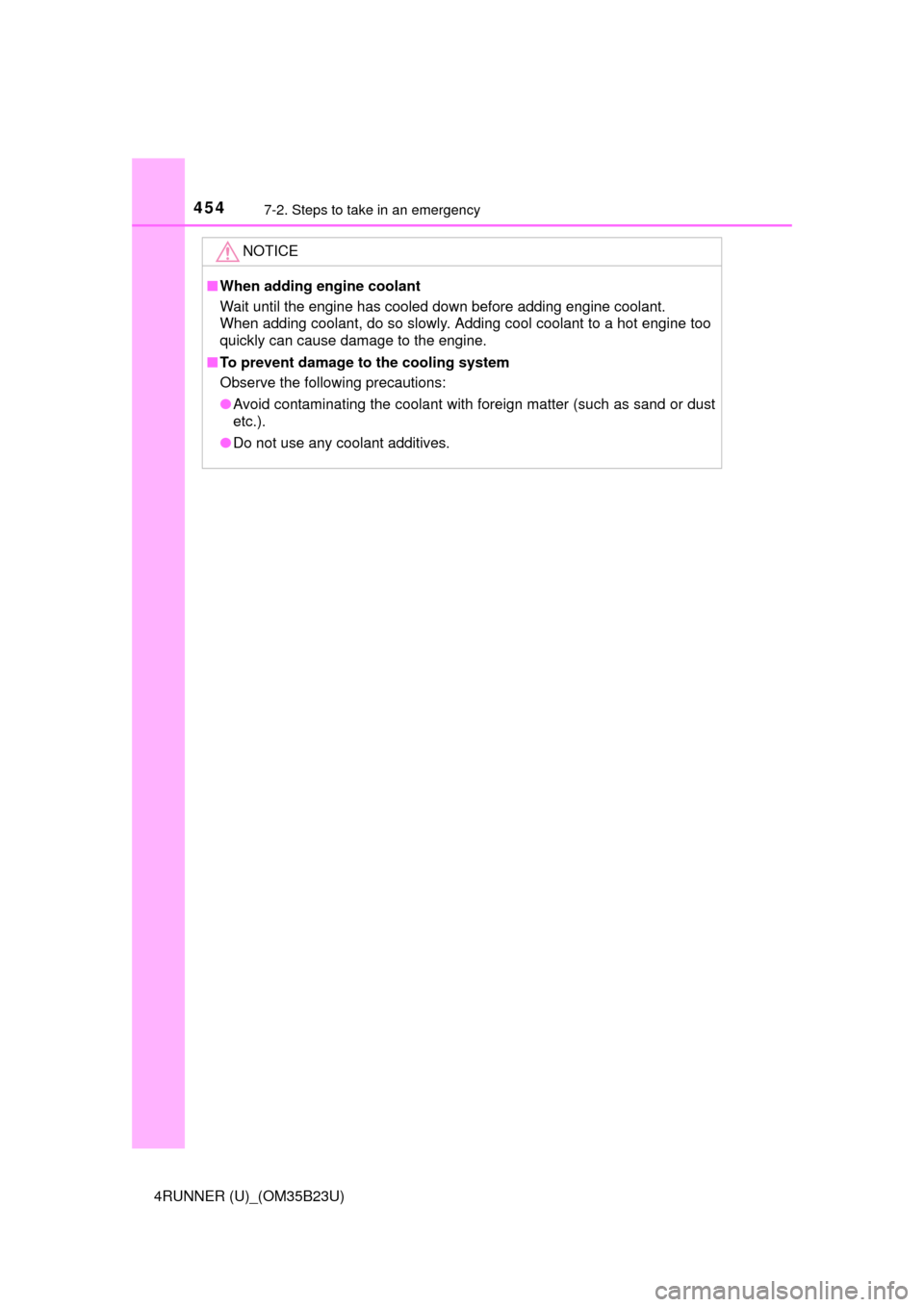
4547-2. Steps to take in an emergency
4RUNNER (U)_(OM35B23U)
NOTICE
■When adding engine coolant
Wait until the engine has cooled down before adding engine coolant.
When adding coolant, do so slowly. Adding cool coolant to a hot engine too
quickly can cause damage to the engine.
■To prevent damage to the cooling system
Observe the following precautions:
●Avoid contaminating the coolant with foreign matter (such as sand or dust
etc.).
●Do not use any coolant additives.
Page 455 of 528
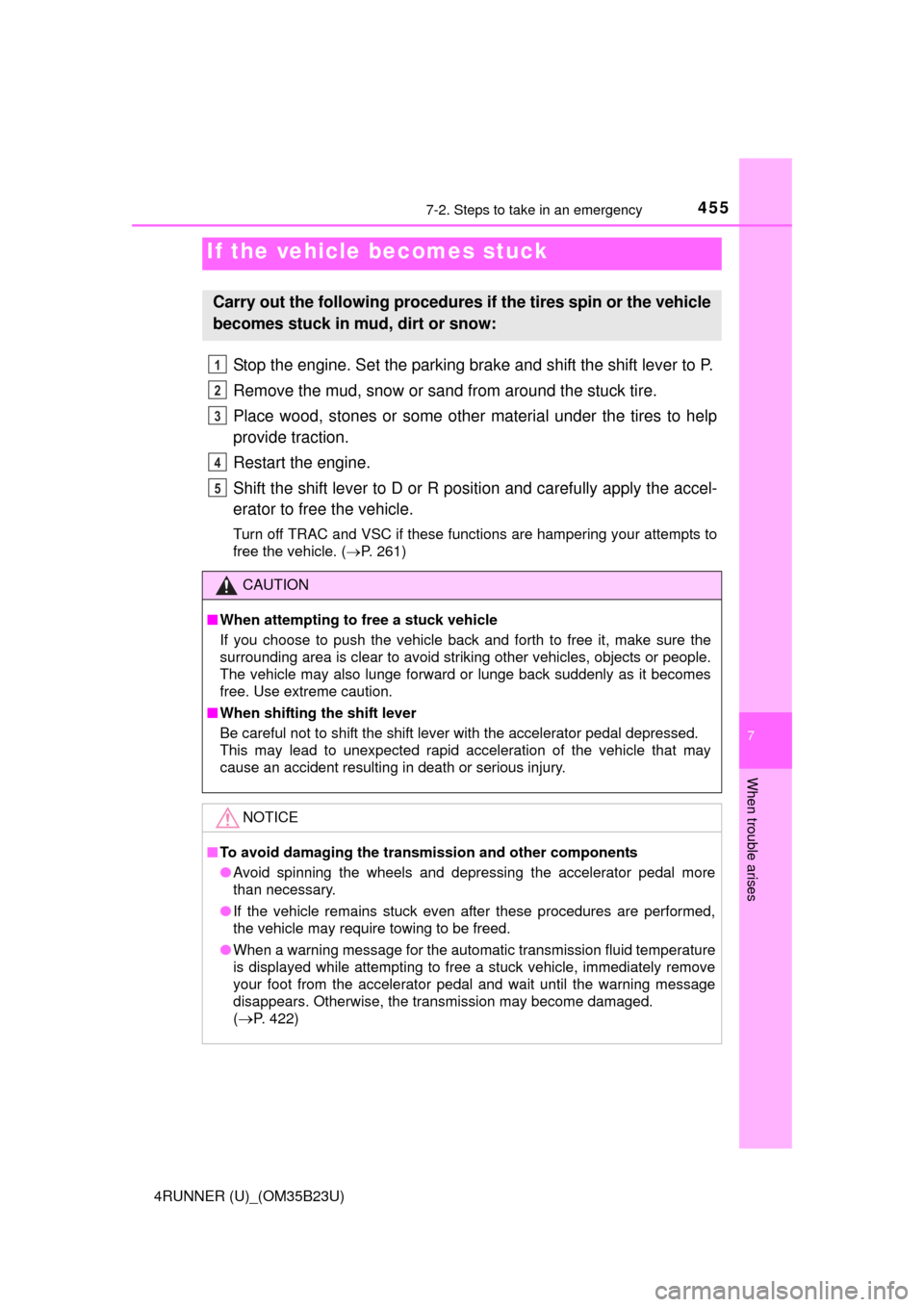
4557-2. Steps to take in an emergency
7
When trouble arises
4RUNNER (U)_(OM35B23U)
Stop the engine. Set the parking brake and shift the shift lever to P.
Remove the mud, snow or sand from around the stuck tire.
Place wood, stones or some other material under the tires to help
provide traction.
Restart the engine.
Shift the shift lever to D or R position and carefully apply the accel-
erator to free the vehicle.
Turn off TRAC and VSC if these functions are hampering your attempts to
free the vehicle. (P. 261)
If the vehicle becomes stuck
Carry out the following procedures if the tires spin or the vehicle
becomes stuck in mud, dirt or snow:
CAUTION
■When attempting to free a stuck vehicle
If you choose to push the vehicle back and forth to free it, make sure the
surrounding area is clear to avoid striking other vehicles, objects or people.
The vehicle may also lunge forward or lunge back suddenly as it becomes
free. Use extreme caution.
■When shifting the shift lever
Be careful not to shift the shift lever with the accelerator pedal depressed.
This may lead to unexpected rapid acceleration of the vehicle that may
cause an accident resulting in death or serious injury.
NOTICE
■To avoid damaging the transmission and other components
●Avoid spinning the wheels and depressing the accelerator pedal more
than necessary.
●If the vehicle remains stuck even after these procedures are performed,
the vehicle may require towing to be freed.
●When a warning message for the automatic transmission fluid temperature
is displayed while attempting to free a stuck vehicle, immediately remove
your foot from the accelerator pedal and wait until the warning message
disappears. Otherwise, the transmission may become damaged.
(
P. 422)
1
2
3
4
5
Page 456 of 528

4567-2. Steps to take in an emergency
4RUNNER (U)_(OM35B23U)
Page 457 of 528

457
Vehicle specifications8
4RUNNER (U)_(OM35B23U)8-1. Specifications
Maintenance data
(fuel, oil level, etc.) .......... 458
Fuel information ................ 470
Tire information ................. 473
8-2. Customization
Customizable features ...... 485
8-3. Items to initialize
Items to initialize ............... 492
Page 458 of 528
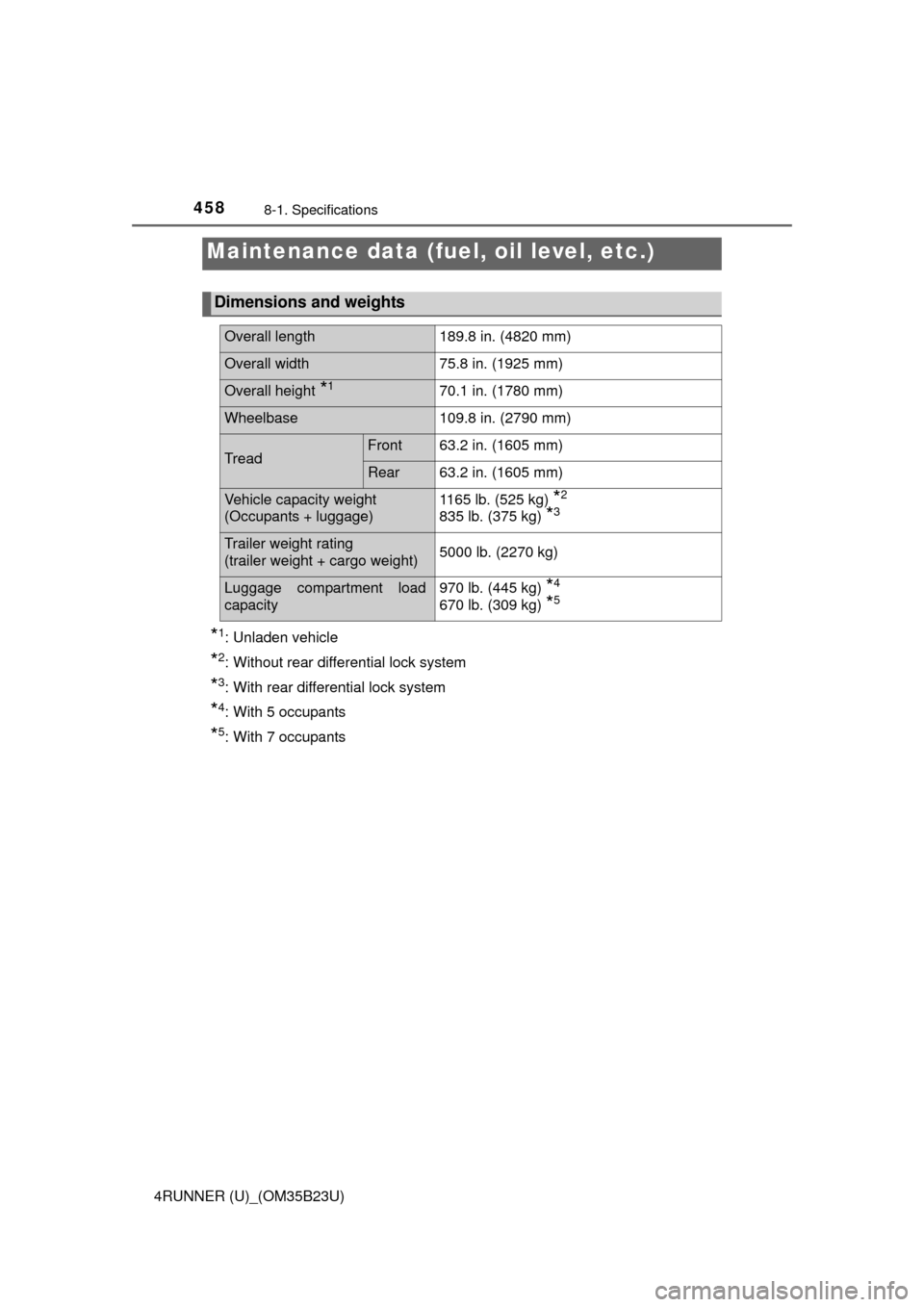
458
4RUNNER (U)_(OM35B23U)
8-1. Specifications
*1: Unladen vehicle
*2: Without rear differential lock system
*3: With rear differential lock system
*4: With 5 occupants
*5: With 7 occupants
Maintenance data (fuel, oil level, etc.)
Dimensions and weights
Overall length189.8 in. (4820 mm)
Overall width75.8 in. (1925 mm)
Overall height *170.1 in. (1780 mm)
Wheelbase109.8 in. (2790 mm)
TreadFront63.2 in. (1605 mm)
Rear63.2 in. (1605 mm)
Vehicle capacity weight
(Occupants + luggage)1165 lb. (525 kg) *2
835 lb. (375 kg) *3
Trailer weight rating
(trailer weight + cargo weight)5000 lb. (2270 kg)
Luggage compartment load
capacity970 lb. (445 kg) *4
670 lb. (309 kg) *5
Page 459 of 528
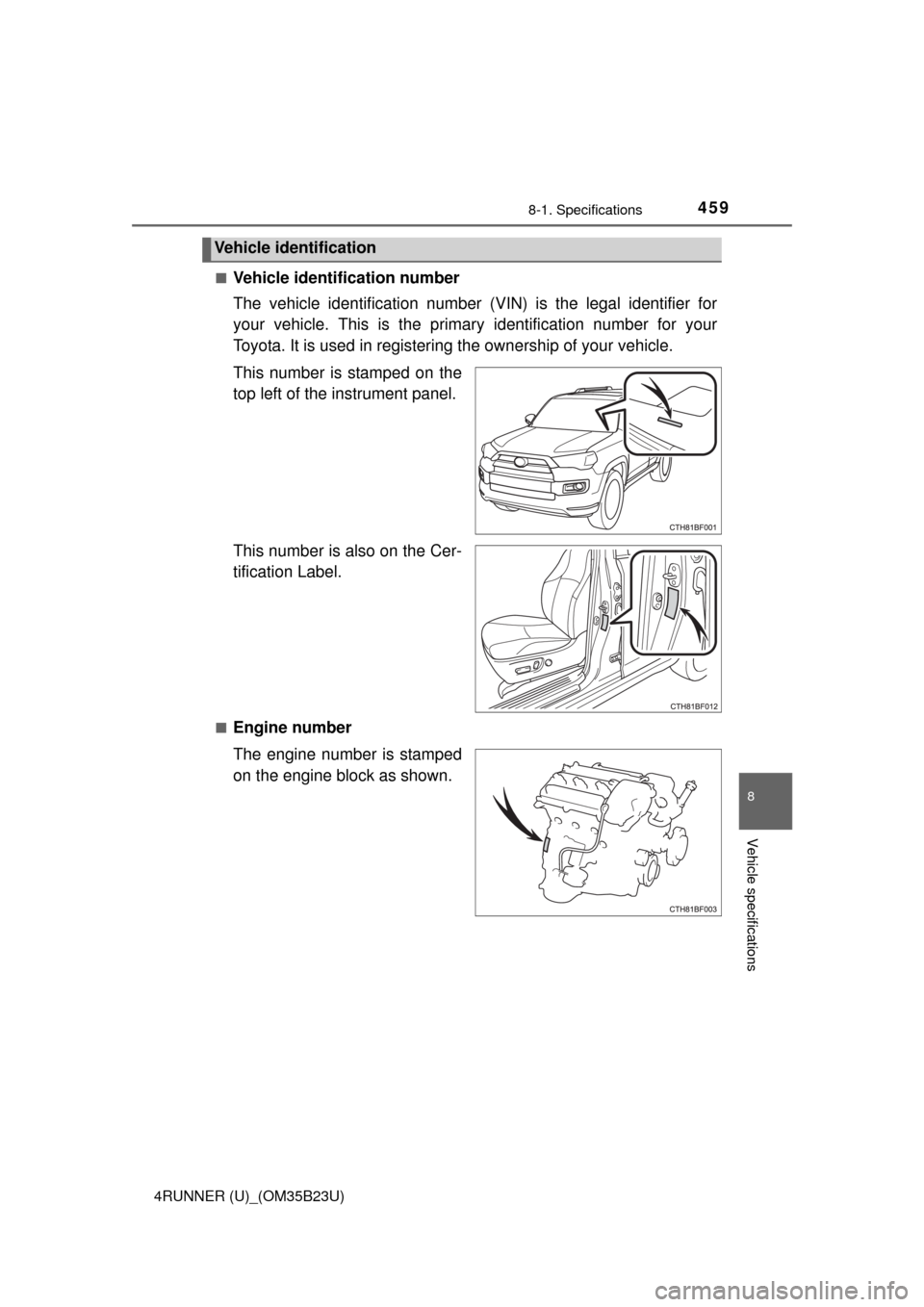
4598-1. Specifications
8
Vehicle specifications
4RUNNER (U)_(OM35B23U)■
Vehicle identification number
The vehicle identification number (VIN) is the legal identifier for
your vehicle. This is the primary identification number for your
Toyota. It is used in registering the ownership of your vehicle.
This number is stamped on the
top left of the instrument panel.
This number is also on the Cer-
tification Label.
■Engine number
The engine number is stamped
on the engine block as shown.
Vehicle identification
Page 460 of 528
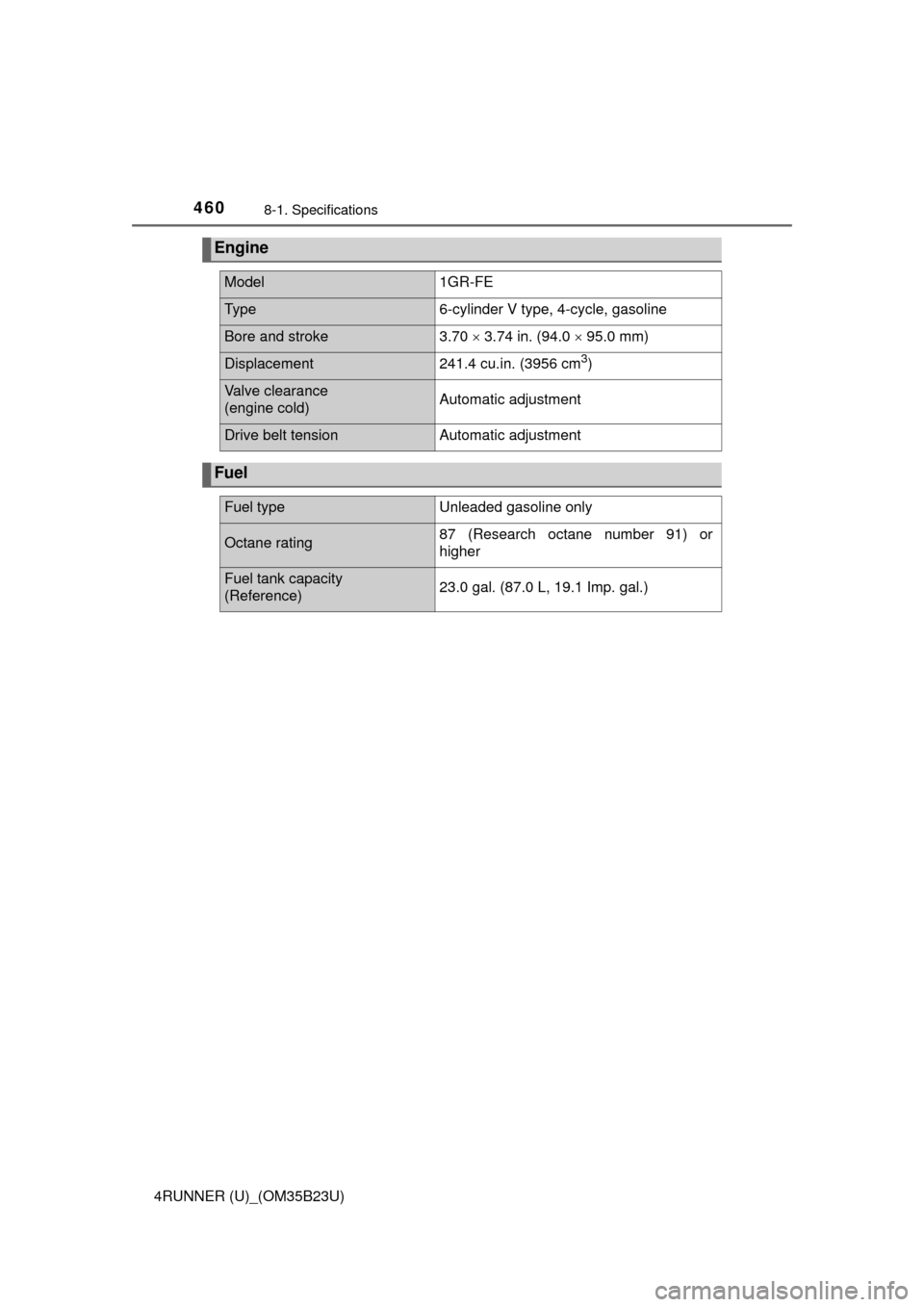
4608-1. Specifications
4RUNNER (U)_(OM35B23U)
Engine
Model1GR-FE
Ty p e6-cylinder V type, 4-cycle, gasoline
Bore and stroke3.70 3.74 in. (94.0 95.0 mm)
Displacement241.4 cu.in. (3956 cm3)
Valve clearance
(engine cold)Automatic adjustment
Drive belt tensionAutomatic adjustment
Fuel
Fuel typeUnleaded gasoline only
Octane rating87 (Research octane number 91) or
higher
Fuel tank capacity
(Reference)23.0 gal. (87.0 L, 19.1 Imp. gal.)